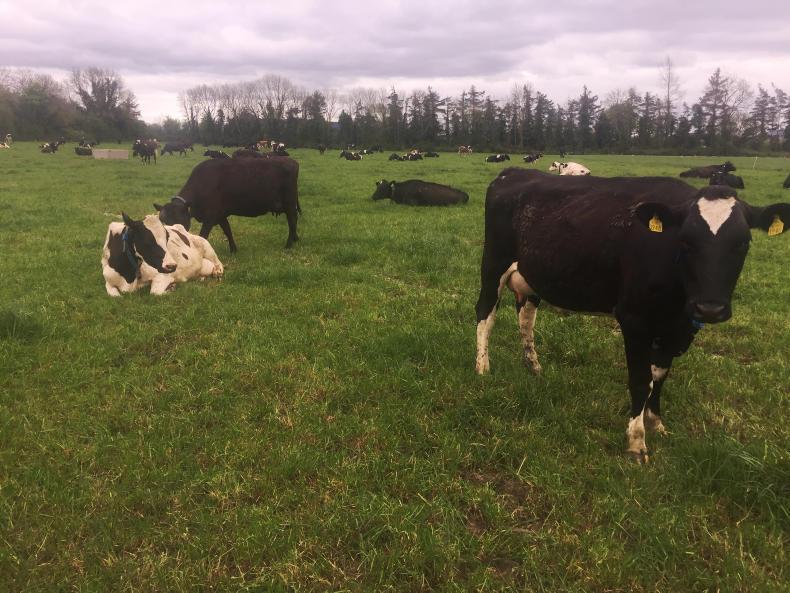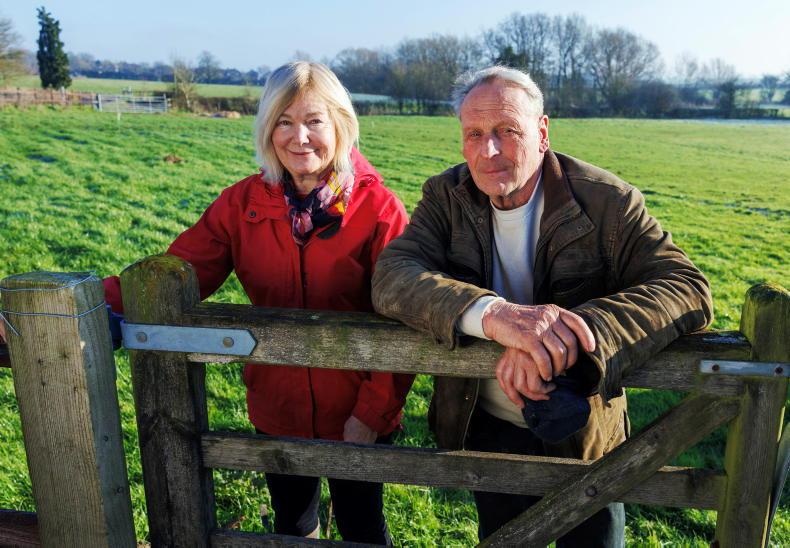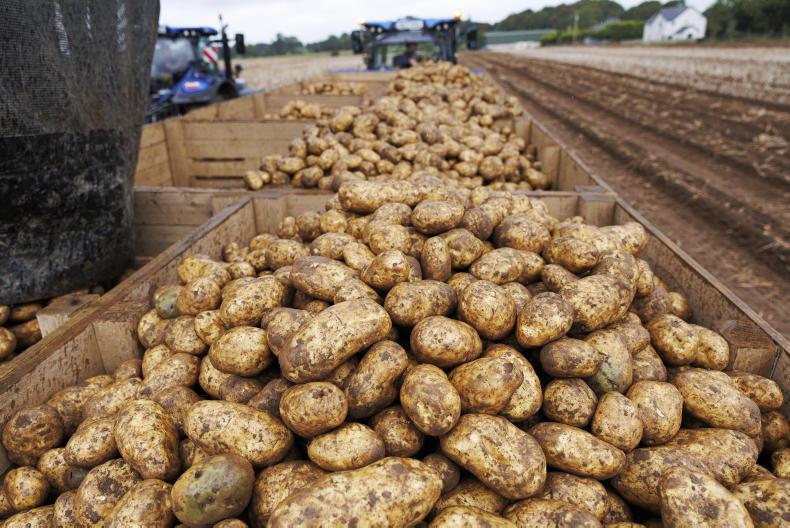There is reason for optimism among dairy farmers at the moment. Milk price is nearly 10c/l higher than this time last year and it looks fairly stable for the year. The weather has been excellent. April 2017 has been one of the driest on record and while grass is a bit back on average, it has been sufficient for most farmers. The other pleasing thing is that cows are milking well, with milk supplies up nationally by between 12% and 15% compared to this time last year.
Last Friday, I sat in on a discussion group meeting in Limerick. The farmers were from all over Munster and were sharp at measuring grass. The host farmer was stocked at 4.81 cows/ha, had a farm cover of 698kg/ha or 145kg/cow and recorded a growth rate of 71kg/day up to the previous Monday.
We measured a couple of paddocks on Friday and the growth rate between Monday and Friday was only 50kg/day and this was on the paddocks that had grass; regrowth was much slower on the grazed paddocks.
He was five days away from starting the third round, and the cover on this paddock was only 800kg. It was doubtful if it would have a cover of 1,000kg by the time the cows were going into it. He was feeding 1.5kg of meal per cow. He had a paddock closed for silage that had a cover of about 2,000kg on it.
This was last Friday and while the sun was beating down there was a cold wind blowing and if you didn’t keep walking you’d get a chill. The forecast was giving rain over the weekend and milder temperatures for this week so this was centre of the discussion.
It was pretty obvious to everyone that grass was going to be very tight over the coming days, on nearly all farms. Some farmers said this was a great position to be in, that if you’re not tight for grass now you’ve done something wrong, The theory is that when you’re tight for grass the grazing residuals are better, pre-grazing yields are lower, surpluses are avoided and you will have better-quality grass in the next round.
The residuals on the host farm were excellent. The field that the cows came out of the night before looked like a golf course. Yet, when the post-grazing height was calculated with a plate meter the height was 4.3cm. But there was no leaf left behind so everyone was happy with the job they had done.
Cows were on 24- and 36-hour grazings depending on the paddock size and the cover. The host farmer said that since he went for bigger paddocks, milk yield and protein percent increased, compared with 12-hour breaks in the past. The cows were milking 26l/day at 3.55% protein and 4.21% fat or 2.07kgMS/cow/day.
The feeling was that if he could get over the next four or five days that the grass would take off again. Since then, it has rained and it has become much milder so growth rates have inreased, but farm cover is still low. Some suggestions to get over the next few days included increasing the meal to 3-4kg/cow/day but it was felt that this wouldn’t make enough of a difference at reducing demand.
One farmer in the group was feeding 4kg DM per cow of silage as he had a farm cover of 115kg/cow and was stocked very highly. He was spreading out three round bales of good-quality silage in the paddock to a herd of 170 cows.
The other option discussed was to graze the field that was earmarked for silage. This had a cover of 2,000kg and was intended to be cut for round bales so it wasn’t fertilised for a big first cut. The farmers felt that this was the best option as it had the most impact and was the least costly way of getting in extra feed. They suggested not cleaning it out properly and closing it up for silage again after grazing.
Reseeding
While we were on the farm, the contractor was in sowing grass seeds. The variety being sown was Aberplentiful in a monoculture, so only one variety along with clover. The farmer has totally moved away from using grass seed mixes and now only sows monocultures. The average growth rate on the farm over the last three years is 15.5t/ha.
On top of this, he now sows mostly tetraploids, on what would be considered by most to be a heavy enough farm. His experience is that tetraploids are more digestible, grow more, are grazed more often and recover from poaching faster than diploids. He says that his cows much prefer grazing a tetraploid than a dense diploid. These views were echoed by other farmers in the group.
Fertiliser
The next topic discussed was fertiliser spreading. One member of the group said he only spread urea all last year and intends to do the same this year. On a per-unit-of-nitrogen basis, urea is cheaper. He said he grew more grass than before. He uses urea with sulphur and uses protected urea during the summer months if conditions are dry.
The host farmer was just after spreading two bags per acre of 18:6:12 across the farm. His next round would be nitrogen and sulphur. He was told that he should have had sulphur out before now. The feeling among the group was that May was too late to start spreading sulphur and that it should be spread from the start back in January.
The suggestion is that where high molybdenum is not an issue, sulphur should be spread at a rate of 10% of nitrogen. So if 250kg/ha of nitrogen is spread in the year then 25kg/ha of sulphur should be spread and drip feeding this across the year is better than one big bang.
The farm we were on is low in potash (K). Soil sample results from 2013, 2015 and 2017 show a steady decline in K levels to the point where now 60% of the farm is at index 1 and 2. Some farmers thought this was great news as it showed there is potential in the farm for more than 15.5t.ha of growth if the K issue was addressed.
It was suggested to the farmer that two bags/acre of muriate of potash should be spread in two applications in August and October. Others suggested spreading 20:0:19 for the rest of the summer. He was advised not to spread too much at once as it could lock up the absorption of magnesium in the cows.
There was some debate about milk production and whose herd was actually performing the best within the group. There was a variation in cow type and meal feeding levels between the farms. Some members were producing up to 2.3kgMS/cow/day while others were producing less than 1.9kgMS/cow.
From listening to the discussion, it was fairly obvious that some of the farmers don’t understand how A+B-C milk pricing works or how a herd producing 2.2kgMS/cow/day could be making less money than a herd producing 2kgMS/cow/day.
See table 1 for an explanation. The key thing to remember is that you are paid for kilos of protein, you are paid for kilos of fat and you are penalised for litres of milk. Take the Dairygold milk price for last month of €6.391/kg of protein and €3.155/kg of fat (mid-ranking on milk price league) and take the price of meal at €250/t.
A typical herd milking 28l at national average fat of 4.10% and protein of 3.45% (2.18kgMS/cow) and feeding 3.5kg of meal is making less money per day than a herd doing 24l per day but with higher constituents, eg 4.60% fat and 3.60% protein (2.02kgMS/cow) and not feeding meal.
In this example, the high-yielding herd is making €8.09/cow/day while the low yielding herd is making €8.23/cow/day, even after taking account of alternative methods of magnesium supplementation. While the differences are not massive, it does highlight a number of things.
Firstly, milk yield, whether litres or kg or milk solids, is a crude way to determine the value of your milk. While volume drives milk solids output, in an A+B-C payment system it is constituents that drive milk price. You should always pick bulls that will increase fat and protein content, not volume, as you are actually penalised for volume.
Secondly, when milk prices fall, the differential between the value of fat and protein and the volume deduction reduces, so the penalty for volume, as a proportion of milk price, increases. This is why farmers with lower constituents but higher volumes get even lower milk prices when prices are low anyway.
Farmers who feed meal to drive output should work out, using an A+B-C milk price calculator, how much extra profit will be made by producing more volume.














SHARING OPTIONS